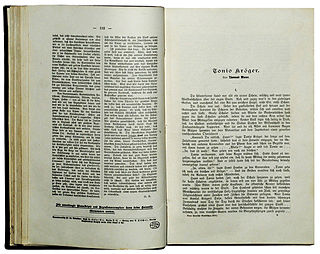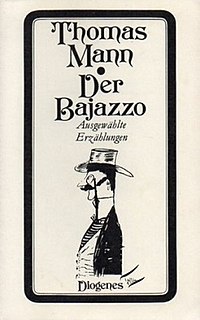
Paul Thomas Mann was a German novelist, short story writer, social critic, philanthropist, essayist, and the 1929 Nobel Prize in Literature laureate. His highly symbolic and ironic epic novels and novellas are noted for their insight into the psychology of the artist and the intellectual. His analysis and critique of the European and German soul used modernized versions of German and Biblical stories, as well as the ideas of Johann Wolfgang von Goethe, Friedrich Nietzsche, and Arthur Schopenhauer.
John Innes Mackintosh Stewart HFRSE was a Scottish novelist and academic. He is equally well known for the works of literary criticism and contemporary novels published under his real name and for the crime fiction published under the pseudonym of Michael Innes.
This article contains information about the literary events and publications of 1935.

Robert William Chambers was an American artist and fiction writer, best known for his book of short stories titled The King in Yellow, published in 1895.

Death in Venice (German: Der Tod in Venedig) is a novella written by the German author Thomas Mann published in 1912. The work presents a great writer who visits Venice and is liberated, uplifted, and then increasingly obsessed by the sight of a stunningly beautiful youth.

John Richard Schlesinger was an English film and stage director, and actor. He won an Academy Award for Best Director for Midnight Cowboy, and was nominated for two other films.
Thomas Ligotti is a contemporary American horror writer. His writings have been noted as being rooted in several literary genres – most prominently weird fiction – and have overall been described by many critics as works of philosophical horror, often formed into short stories and novellas in the tradition of gothic fiction. The worldview espoused by Ligotti in his fiction and non-fiction is pessimistic and nihilistic. The Washington Post called him "the best kept secret in contemporary horror fiction."

Across the River and Into the Trees is a novel by American writer Ernest Hemingway, published by Charles Scribner's Sons in 1950, after first being serialized in Cosmopolitan magazine earlier that year. The title is derived from the last words of U.S. Civil War Confederate General Thomas J. (Stonewall) Jackson: “Let us cross over the river and rest under the shade of the trees.”

James Hadley Chase was an English writer. While his birth name was René Lodge Brabazon Raymond, he was well known by his various pseudonyms, including James Hadley Chase, James L. Docherty, Raymond Marshall, R. Raymond, and Ambrose Grant. He was one of the best known thriller writers of all time. The canon of Chase, comprising 90 titles, earned him a reputation as the king of thriller writers in Europe. He was also one of the internationally best-selling authors, and to date 50 of his books have been made into films.

Thomas Mann Randolph Jr. was an American planter, soldier, and politician from Virginia. He served as a member of both houses of the Virginia General Assembly, a representative in the United States Congress, and as the 21st governor of Virginia, from 1819–1822. He married Martha Jefferson, the oldest daughter of Thomas Jefferson, third President of the United States. They had eleven children who survived childhood. As an adult, Randolph developed alcoholism, and he and his wife separated for some time before his death.

Tonio Kröger is a novella by Thomas Mann, written early in 1901, when he was 25. It was first published in 1903. A. A. Knopf in New York published the first American edition in 1936, translated by Helen Tracy Lowe-Porter.
Tobias Hill is a British poet, essayist, writer of short stories and novelist.

Confessions of Felix Krull is an unfinished 1954 novel by the German author Thomas Mann.

Barbara Chase-Riboud is an American visual artist and sculptor, bestselling novelist, and award-winning poet.

The Clown is a short story by the 19th and 20th-century German author Thomas Mann. It was first published in the German literary magazine Neue Rundschau in 1897, and were after his death, published as part of the collection Little Herr Freiedemann and Death in Venice and Other Stories.

Christopher Hitchens was a prolific English-American author, political journalist and literary critic. His books, essays, and journalistic career spanned more than four decades. Recognized as a public intellectual, he was a staple of talk shows and lecture circuits. Hitchens was a columnist and literary critic at The Atlantic, Vanity Fair, Slate, World Affairs, The Nation, Free Inquiry, and a variety of other media outlets.

Władysław Gerard Jan Nepomuk Marya Moes was a Polish landowner and has been claimed as the inspiration for the character Tadzio in Thomas Mann’s novella Death in Venice, which was filmed as Death in Venice by Luchino Visconti.

Magnus Chase and the Gods of Asgard is a trilogy of fantasy novels written by American author Rick Riordan with the subject of Norse mythology and published by Disney-Hyperion. It is based on Norse mythology and is set in the same universe as the Camp Half-Blood Chronicles and The Kane Chronicles series. The first book, The Sword of Summer, was released on October 6, 2015. The second book, The Hammer of Thor, was released on October 4, 2016. The Ship of the Dead, the third book, was released on October 3, 2017.

"The Road to the Churchyard" is a short story by Thomas Mann. Initially appeared in 1900 in Simplicissimus. Appeared in 1903 in an anthology of Mann's six short stories, entitled collectively as Six Novellen. Published after his death as part of Death in Venice and Other Stories.
Thomas Mann Randolph Sr. served in the Virginia House of Burgesses, the Revolutionary conventions of 1775 and 1776, and the Virginia state legislature. Married twice, he fathered 15 children. One marriage was to a cousin, Anne Cary, with whom they had 13 children. His second marriage, which resulted in two children, caused a dissention among family members. The youngest son, with the same name as his half-brother, Thomas Mann Randolph, inherited the family plantation, Tuckahoe plantation. Randolph expanded upon the house that began to be built during his parent's short marriage. Orphaned as a young boy, Randolph continued work on Tuckahoe when he came of age. He also purchased Salisbury house, which was used during his lifetime as a hunting lodge.















